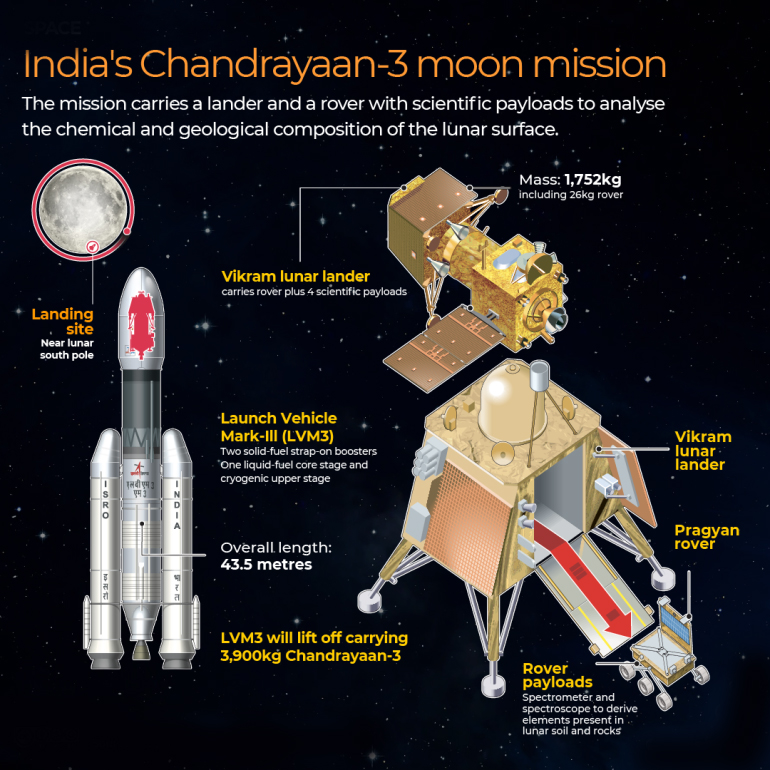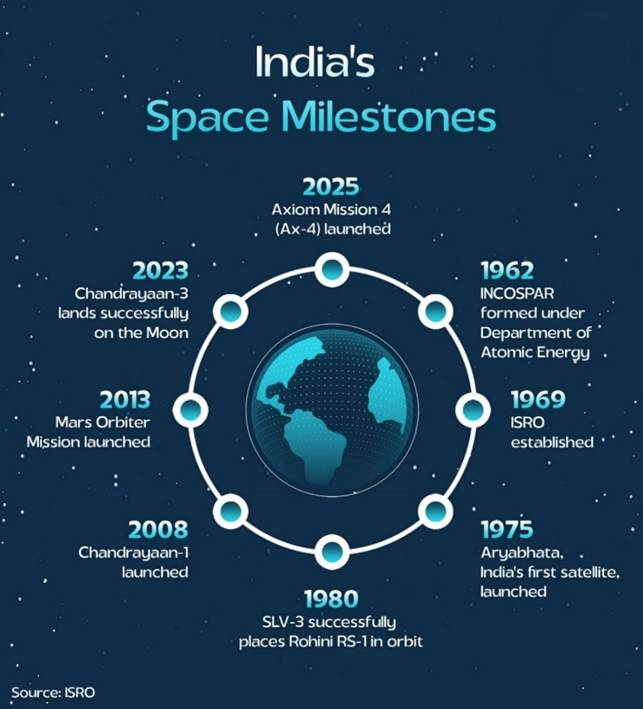Introduction
India is going to celebrate its second National Space Day on August 23. The historic success of Chandrayaan–3 not only established India as a global space power but also added a new achievement to the collective repository of human knowledge. The upcoming Gaganyaan mission, Chandrayaan–4, and the proposed Bharat Antariksh Station are set to make this journey even more glorious. At the same time, the growing contribution of private companies is evidence that India is now moving beyond traditional space exploration toward commercial and strategic horizons.
- However, amid all these successes, an important question arises: India’s National Space Law. To provide sustainability and credibility to India’s progress in the global race for space exploration, innovation, and commercialization, the need for a strong legal framework has now become clearer than ever before.
Global Space Law: The Foundational Framework:
At the international level, the United Nations has created five major treaties to regulate space activities. The most important among them is the Outer Space Treaty (1967), which established the principle that space is the common heritage of all humanity and cannot be claimed by any nation as its sovereign territory.
- This treaty also ensures that space will be used only for peaceful purposes.
- Alongside it, the Liability Convention (1972), Registration Convention (1976) and others made states responsible for their national space programs and private activities.
The UN treaties provide the basic principles for space activities—from peaceful use to state responsibility and liability. But the responsibility of translating these principles into reality rests with national laws. In other words, treaties provide guidance, but their implementation is ensured by domestic legislation.
India’s Position: Policy versus Law
India has signed and ratified these treaties, but a comprehensive national space legislation has not yet been enacted.
- The Indian Space Policy (2023) and the IN-SPACe Norms, Guidelines and Procedures (NPG) have encouraged private sector participation.
- Similarly, the Bureau of Indian Standards (BIS) has prepared a list of Indian standards for the space industry, ensuring compliance with safety measures.
Yet, so far, only the first essential component—technical regulation—has been addressed. The second component, i.e., a comprehensive legislative framework (textual law), still remains pending. This framework would constitute India’s Space Act, implementing the provisions of international treaties at the national level.
Industry Perspective: Demand for Clarity and Stability:
-
- The growing role of private space companies has given India new momentum, but regulatory uncertainty remains a challenge.
- Leading private players include Skyroot Aerospace, Agnikul Cosmos, and Pixxel—active in satellite manufacturing, launch vehicles, data services, and space-based applications.
- For investors, legal certainty, licensing processes, insurance, and risk management frameworks are crucial.
- A National Space Law would provide them both protection and guidance.
- The Indian Space Association (ISpA) has emphasized the need to grant statutory authority to IN-SPACe. Currently, it operates without complete legal backing.
- The growing role of private space companies has given India new momentum, but regulatory uncertainty remains a challenge.
- IN-SPACe (Indian National Space Promotion and Authorization Centre) is an autonomous nodal agency under the Department of Space (DOS), approved by the central government. It acts as a bridge between ISRO (Indian Space Research Organisation) and the private space sector. Its primary objective is to promote, enable, authorize, and supervise the participation of non-governmental entities (NGEs) in space activities.
- If clear provisions regarding licensing procedures, eligibility criteria, application timelines, fees, and grounds for rejection are codified in law, it will instill confidence among investors and companies.
- Private players are also demanding that 100% FDI through the automatic route be allowed in satellite component manufacturing. This would provide Indian startups with both capital and technology.
- Additionally, a robust insurance framework is essential. Internationally, India bears full responsibility for any damage, but for private players, mandatory third-party insurance should be made a requirement to cover losses from high-value space assets.

Other priorities for the industry include:
- Protection of Intellectual Property Rights (IPR),
- Clear accident investigation procedures,
- Binding provisions for space debris management,
- An integrated framework for space data and satellite communication,
- Establishment of an independent appellate body.
International Credibility and Reputation:
Countries such as the United States, France, Japan, and Australia have already implemented their national space laws.
- Through these, they are not only encouraging their private industries but also strengthening their positions on international platforms.
- If India too acts in time, it will be able to enhance its credibility and influence as a responsible space power.
National Security and Strategic Interests:
India’s space program is significant not just scientifically but also strategically.
- Satellite-based communication, navigation, surveillance, and missile guidance are integral to modern warfare.
- The US, Russia, and China have already incorporated space forces and anti-satellite weapons into their military strategies.
- In such a scenario, India must also safeguard its interests and ensure a balance between civilian and military uses through clear legal provisions.
Space Debris and Sustainable Development:
One of the biggest challenges today is space debris. It is estimated that more than 30,000 large debris fragments are orbiting Earth.
- If India enacts a National Space Law soon, it can mandate satellite life-cycle management and debris disposal requirements.
- This would strengthen India’s image as a responsible space power.
Opportunities and Challenges:
Opportunities:
- The global space economy is expected to exceed $1 trillion by 2040.
- India’s cost-effective space program can make it a hub for foreign investment and partnerships.
- A clear legal framework would promote triangular cooperation between industry, academia, and government.
Challenges:
- The law must remain flexible, keeping in mind technical complexities.
- Balancing security concerns with private sector encouragement is difficult.
- Jurisdictional overlaps between ministries and agencies may create hurdles.
The Way Forward:
- Passing the National Space Bill at the earliest is essential.
- IN-SPACe should be given full statutory status as a central regulatory authority for all space activities, ensuring a centralized and empowered system.
- Licensing, liability sharing, and insurance provisions must be clear and practical, providing a safe environment for private companies and startups.
- Protection of IPRs and encouragement of innovation should be an integral part of the law to prevent talent and technology outflow from India.
- Strict compliance with space debris management and sustainability standards must be ensured to strengthen India’s image as a responsible space power.
- To attract foreign investment, a transparent FDI policy is needed, providing Indian startups with easier access to capital and technology.
- Finally, an independent appellate body and dispute-resolution mechanism must be established to ensure fairness, accountability, and regulatory transparency.
Conclusion:
India today stands at a decisive juncture. Its achievements in space technology are unparalleled, but without a strong legal framework, this progress may remain incomplete. A National Space Law would provide predictability, legal clarity, and a stable regulatory environment for both government and private players.
| Main Question: |








